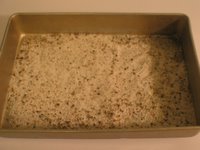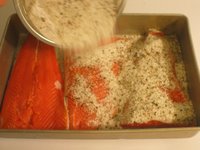The ingredients are as follow:
7 x sugar
5 x coarse salt
3 x ground white pepper
4 x smoked tea leaves
I liked the idea of having a strong pepper flavour so I used a mixture of green, white, black and pink peppercorns instead of white pepper but decided to forego the tea leaves which I believe would only alter the flavour, not the final texture or the curing process itself.

I then placed a part of this mixture in a pan;

Placed three small salmon filet on top;

Covered them with the rest of the mixture;
 And placed a cutting board and four large cans on top to create a press.
And placed a cutting board and four large cans on top to create a press.This time, I placed the fish in its homemade press in the refrigerator for 5 days, turning the filets a couple of time during the process. There was a problem however: I didn’t read the recipe carefully… it clearly stated to use only ¼ cup of the dry mixture per pound of salmon filet and I probably used more than a cup for each of my small filet.

The filets turned out to be very dry and were a bit too sweet for my taste. The saltiness is surprisingly at a more appropriate level than the last time but it is still a bit too high. The fish is also very peppery; it is almost too strong to eat it as is but I am guessing that it would be much nicer when paired with other ingredients (pasta, cheese, bread…).
Next time, I will:
- Use a 50% - 50% ratio for salt and sugar.
- Reduce the amount of sugar and salt used to at least ½ cup per pound of fish filet.
- Use less weight on my press to avoid loosing too much water and thickness.


4 comments:
Your french is better than my english but I'll nevertheless try to give you a small advice in that language...
Place the salmon fillets flesh against flesh, with between the two the salz/pepper mixture, and an even little dill.
Apply a weight then above for applatir fish well.
At the end of 24 or 48 hours according to the taste, it is ready to be tasted.
La prochaine que je m’aventure dans la préparation d’un gravlax, je vais donc placer les filet un par dessus l'autre... c'est tout simple comme truc et ça devrait m'aider à réduire la perte excessive d'eau et l'apport exagéré de sel. Merci pour ce truc débo!
Débo m'a envoyé sa recette de gravlax par email. J'ose la recopier ici mais vous pouvez aussi la trouver sur son site web,
Les Agapes
"Mélanger 2 cuillères à soupe de sel, 1 cuillère à soupe de sucre et 1 cuillère à café de poivre.
Etaler la moitié sur un filet de saumon (côté chair).
Recouvrir d'aneth, puis de l'autre filet du saumon "épicé" de la même manière.
Placer au frais 48h sous un poids (attention, ça coule...donc ne pas hésiter à placer le poisson dans un plat creux pour récupérer le jus...ailleurs qu'au fond du frigo).
Essuyer les filets et les trancher finement (si le gout est trop fort, on peut les rincer)"
Merci Débo!
il faut le laisser moins longtemps dans la saumure...les morceaux de saumon ne sont pas assez épais pour qu'on les laisse plus de 24 heures...On peut aussi essayer la méthode sandwich, qui consiste à superposer 2 morceaux plus court l'un par dessus l'autre et à entourer le tout de papier sarang...j'ai une recette sur mon blog, j'adore le gravlax, j'utilise la recette de mes grands parents qui sont d'origine scandinave.....
Post a Comment